
Naked-eye sky gazing is an enjoyable activity. Although today "go-to" telescopes largely facilitate sky access to amateur astronomers, naked-eye sky knowledge may always be considered a duty for any serious observer. Naked-eye sky observation has been the only way to access sky until the 17th century AD and this remains a pleasure to find one's way in night sky, to know main stars' names or to spot the general shape of a constellation. Naked-eye sky learning is not excessively complicated even if it requires some patience It's impossible to see the entire sky along one night only and you will have to let the seasons pass to gain access to the various parts of the celestial sphere. This tutorial will lead you through this apprenticeship of the night sky. After some reflexions and some base tips about the observational environment you will head to the constellations and main figures of northern hemisphere skies. Northern skies are the skies whence astronomy, in its most basic sense, had been born with classical civilizations, the concepts of which eventually turned into the classical skies of Orion, the Hunter, Cygnus, the Swan, or Andromeda, Andromeda. From the mid-latitudes of a given hemisphere, a observer mostly will be able to observe a 3/4 only of the whole celestial sphere. To observe the remaining, he will to move South or North
| Observational Environment | Observing |
Best possible naked-eye sky learning environment is a free 360° horizon. If not, a backyard is useful anyway. Or even a balcony or a simple window. Even if you see less stars and if you have to learn the sky "slice by slice", you will learn anyway. The most important tip is that your eyes progressively get used to the darkness hence progressively see more stars. This is a well known rule of amateur astronomers. Once in a session, just avoid to expose yourself back to any source of light. Should you have to use any documentation as often the case, just use a red flashlight or use the night vision toggle of your planetarium software. Red flashlight are easily found at amateur astronomy retailers or you may easily tweak one: just find a red-tinted bulb, or paint one, or place any convenient red filter on the flashlight. Should you observe from a city or a building, street lamps or other light sources will surely be unwanted sources of light. Just find the appropriate angle which will elude them and just avoid to expose you back to the sources during the observation session
Another point is that you just have to be comfortable while observing. First, you may observe standing, or sitting on a chair or an armchair, at your convenience. On the other hand, always think about how you will get clothed. Observing is always best done in open air (or with a window opened) and some nights may be cold! Dress accordingly and wear appropriate protections like gloves or good shoes, if needed. You have to feel comfortable. By summertime, be mindful of insects! In case, just warn your neighbours that should they see a strange shadow with heavy woollen hoods on the head, it's just you learning the sky ;-) A last thing too: should you decide to go to some dark place outdoor to have a better horizon, just think in terms of safety first. Dark places, reasonably, are not the safer places around!
For clarity and use, stars you see in the night sky, are grouped into constellations. Constellations are boundaries inside which a group of stars are seen close together, much of them evoking a figure. In most cases these stars are vastly distant from each other and they are seen forming the constellation figure only by an effect of perspective. As seen from Earth, they are looking like they are close together . Diverse civilizations saw diverse objects, myths or symbols into the skies. The constellations we are using today are mostly due to the Babylonians and Greeks. Some were added when discoverers about the 16th century ventured into the southern hemisphere. Definitive constellations boundaries were fixed in 1930 by the International Astronomical Union (IAU). Constellations, for both hemispheres, are at the number of 88. On the other hand, amateur astronomers are used to memorize some alignments which help to find one's way to a constellation or to identify such or such star. At last different parts of the sky are seen along the year due to Earth's revolution along its orbit. It may be assumed that each season comes with its pattern of constellations and stars. Winter sky e.g. is the sky of constellations such as Orion, Canis Major, the Great Dog, and Gemini, the Twins, as the summer sky is characterized by the summer triangle, that is a large pattern of stars formed by the main bright stars of the three constellations of Lyra, the Lyre, Aquila, the Eagle, and Cygnus, the Swan. All this brings that sky-learning is working along the four seasons. From winter to fall you will learn what constellations are seen in the sky and how to find and identifiy them
For any observational purpose, you will have to learn what part of the sky is at your disposal. As a rule of thumb, should you usually see the sun setting, this means that you observation post if facing West. Should you usually see the Sun rising, you are facing East. About midday, Sun is about your South. Hence North is in the opposite direction. A easy way to find the North-South axis by day in the northern hemisphere is to use a watch with needles. Just place the hour needle towards the Sun as the South, then, is found midway between that needle and the 12 hour-mark on the watch's dial. A better way to find too is to use a chart, or a compass
The logics for our night sky learning training, as exposed herein, is a logics usually admitted by the amateur astronomers community. It's mostly based on the use of two sky charts, a one concerning the western, and the other the eastern, horizons. The trainee thus will just have to follow, charts in hands, our text as our method mostly is juxtaposing and descriptive. That means that you will have to spot the constellations from the charts, and to follow our descriptions! Of help to check you identify well constellations, are some softwares useable with your smartphone -- some advanced and also used with a computerized telescope. That works by pointing the smartphone in the direction of a constellation and having its name, bright stars, etc. You will also note that, as far as our site's charts are concerned, they do not bear, by a worry of legibility, any name of the bright stars. As our description refer to such names, just consider that those mostly are, on the chart, the brightest star of the constellation in question
Observations tips are given for night's first part, that is about 10:30 p.m. local time. 'Season' is understood like the time about the middle of it, like, for example, about early November for fall. Color maps with Stellarium. Printer-friendly charts with Cartes du Ciel, Patrick Chevalley. Alignments were hand-drawn as three charts in the first section ("The Great Dipper, Polaris, Cassiopeia") were hand-modified. Each night, the celestial sphere is shifting to the western horizon by 15 degrees per hour. From one month to the next, for a same latitude, a star or constellation will be found back at the same position in the sky with 2 hours earlier. By summer in the northern hemisphere, Earth's nightside is directed towards our Milky Way Galaxy's interior, making the season the best to observe deep sky objects, as some galaxies are also at reach. Mid-spring is the best season for galaxies only
->Caution! A current tendency of the astronomical softwares and charts is to shift from the constellations' shapes as they are usually defined and recognized by the amateur astronomy community. The following color charts on this page are those which are shifting the most in this regard, as the printer-friendly charts are those who do less and are the ones to be used to memorize the basic shapes of the constellations, albeit still not completely accurate. read more!
| The Great Dipper, Polaris, Cassiopeia Winter Sky Spring Sky Summer Sky | Autumn Sky Circumpolar Constellations Alignments of Stars. Concept and Use |
Ursa Major, the Great Bear, is especially seen under the form of the asterism of the Great Dipper. Knowing where to see it is a standard of amateur astronomy. Alignments using its stars allow to find other constellations and it's a fine scenery. Should you not have the Great Dipper at your disposal from where you are observing, you may skip this section as well and directly jump to the season at which you are beginning to observe. Just come back to the Great Dipper, when you will have it in your line of sight!
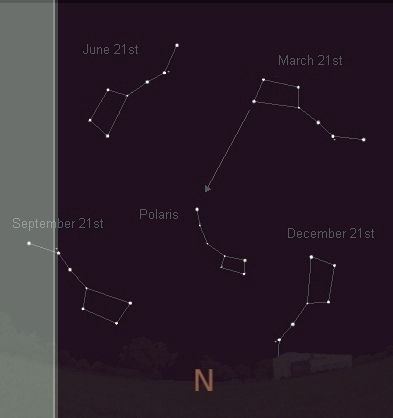 | click to locations of the Great Dipper according to the seasons |
In the northern hemisphere, The Great Dipper is always more or less in the direction of the North. To find the general direction where to look just use this chart which is showing where the Great Dipper is about 10:30 p.m. along the year (some form of latitude may be accepted function of whether any DST system is applied, for example). The Great Dipper is generally sketched like having the form of a saucepan or of a dipper. The three stars forming a curve are like the handle of the saucepan or of the dipper as the four others are the saucepan or the dipper themselves. The form of a bear is only explained by other stars which are part of the constellation Ursa Major. The Great Dipper is useful to find the Polaris, this star which is marking the North and about which the sky seems to be spinning. Just spot the two stars forming the right edge of the saucepan and extend the line they are forming upwards of the dipper. The first, lone, relatively bright, star which is found along the line is the Polaris. Should you wait some time enough facing this star you would notice that stars being at your right have risen above the horizon as those located at your left have dipped. This is due to Earth's axis being directed to the Polaris and Earth rotating eastwards. The night sky is appearing rising East and setting West, rotating about the Polaris. On the other hand, the Polaris is part of another, smaller, saucepan, which is the Little Dipper, or Ursa Minor, the Little Bear

 | click to finding Cassiopeia |
The winter sky is a particularly fine sky. Nights are long and all the southern part of the sky is filled with remarkable constellations as East and West are other fine or interesting constellations. The Milky Way by winter however is seen in the direction of a less luminous arm than by summer. If the southern horizon is available to you, turn South. In the center of the sky spot a large quadrilateral with three stars in a line at its center. It's the constellation of Orion, the Hunter. Top left star of the quadrilateral is Betelgeuse, bottom right one is Rigel. The three stars in line are known as the Orion's Belt. Below them is found the famous Orion Nebula, a diffuse glow which is a dust and gas region where stars are forming. Now, starting at Orion, you can easily find the other great constellations of the winter sky. Use the Orion's Belt. Extend the line right and up and you will spot another bright star. It's Aldebaran, main star to the constellation Taurus, the Bull. Aldebaran is surrounded by a loose, V-shaped group of stars. These are the Hyades, an open cluster, that is a group of stars which are physically close to each other, mostly because they were born from a same gas cloud. Get back to the Orion's Belt. This time, follow it just in the other direction. This other bright star is Sirius, the principal star of the constellation Canis Major, the Great Dog. In the ancient Egypt this star was announcing the summer time. Back again to Orion. Extend the axis Rigel-Betelgeuse upwards and you will find the constellation of Gemini, the Twins. It's another quadrilateral, slightly smaller than Orion's. Two stars, up, left, are Pollux and Castor. And a last alignment from Orion: just use the entire constellation's shape and extend it upwards. Slightly right, beyond two fainter stars belonging to Taurus, the Bull, you meet another bright star. It's Capella, of Auriga, the Charioteer. The Charioteer is mostly a pentagon of stars, below Capella. One of them is part of Taurus, the Bull. Procyon, left of Orion, above Canis Major, the Great Dog, is the last bright star of this remarkable region. It's the main star of Canis Minor, the Little Dog. This flurry of fine constellations is further ornamented with the famous, and fine, Pleiades. The Pleiades are another open cluster, pleasant to look for and to look at, due to its small size. It's located right, slightly up, of Aldebaran
 |  | click to the great winter sky (bare, left; with alignments, right). for the constellations' shape see below at the charts for the western and eastern horizons |
Now turn East. Two fine sights are provided, with Leo, the Lion, and Hydra, the Hydra. About southeast, that long and faint chain of stars is Hydra, the Hydra, which we see now mostly in its upper part. Dead East, Leon, the Lion is another fine constellation. This constellation is relatively well shaping a crouched lion as Regulus and Denebola are its two bright stars. The distinctive, sickle-shaped asterism of stars starting at Regulus, is called 'Leo's Sickle'. Denebola is an Arabic term for the 'tail of the Lion'. Cancer, the Crab, now is high. It's home to the open cluster M44, also called the Beehive, which is found just near the two central stars of the constellation. Northeast, the Great Dipper, albeit high, is a fine target, as one may catch some parts of the constellation which are ill-observed. Coma Berenices, the Berenice's Hair on the other hand, is low, following Leo. It's a region of deep-sky objets. Now West! It's Perseus, Perseus, which is, high, dead West. It's featuring the famed variable star Algol. Cassiopeia, the Queen, another famed sight, is seen northeast. It's now featuring a capital W shape. Triangulum, the Triangle, and Aries, the Ram, are fine small constellations. Southwest, just see how a long, meandering chain of stars is taking at Rigel, at the bottom right of the quadrilateral of Orion. It's the famed Eridanus, the River, a celestial river known since the Antiquity and maybe figuring the Nile river. Eridanus keeps its way under the horizon, down to the southern star Achernar, which is never to be seen under our latitudes. Another object of interest is lying, relatively low, northwest: it's the well-known M31, the Andromeda Galaxy that is! M31 is a view of our own Milky Way Galaxy could we see it from the outside: a large spiral galaxy, with a bulge of old, yellow stars, and spiraling arms where blue, young stars are forming. On the chart, M31 is the faint object just over the 'e' of Andromeda
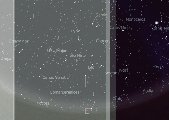 | 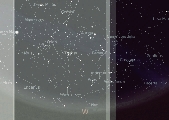 | click to winter sky, eastern horizon (left) and western horizon (right). retrieve printer-friendly charts (eastern horizon, western horizon) |
Spring sky is, of course, a less remarkable sky than the great winter sky, but it's not devoided of interest. The night sky, in spring, is a transitional sky between winter and summemr. Just see, West, how the last part of the constellations of the great winter sky are there, with Procyon, and constellation Canis Minor, the Little Dog, Gemini the Twins, high, and northwest, Auriga, the Charioteer, with the bright Capella. Cancer, the Crab is high, to the upper left of Gemini. This faint constellation is harbouring the M44 open cluster, a fine object to see. The northwest is occupied by the faint fields of Camelopardalis, the Giraffe! A fine sight, during spring, is seen over the southern horizon. Just turn there and see how Hydra, the Hydra, that long and faint chain of stars, high, is stretching from the southeast, to the head of the Hydra, southwest, that small loop of stars. The show is fine further, as three small and fine constellations, are anchoring along Hydra. Corvus, the Crow, Crater, the Cup and Sextans, the Sextant, in this order, from East to West! East now! Northeast, for those with a plain horizon, you'll be able to catch the first stars of Cygnus, the Swan, as the bright star there is Vega, of Lyra, the Lyra. Both are part of a famed figure which will ornate the nights in summer, the Summer Triangle that is! As we're in spring, just like the last constellations of winter are gliding to the horizon West, the first ones of summer are appearing East! Other fine views are seen East during the spring night. The bright star, high, is Arcturus, of Bootes, the Herdsman, the kyte-shaped constellation now left of the star. The other bright star southeast is Spica -'the Fly'- the main star to constellation Virgo, the Virgin. Virgo is famed to harbouring deep-sky galaxies. Libra, the Scales, lower is a fine sight as is Corona Borealis, the Northern Crown, which is lying under Bootes. Draco, the Dragon is fine to see, too, northeast. At last, a fine field is provided with Hercules, the Heroe. Hercules is a quadrilateral of stars, with extensions, looking like arms. Hercules, the Heroe, is home to the famed globular cluster M13 at the 5.9th magnitude 5.9, which is an easy and fine binocular target. In this season, the cluster is located on the upper-right side of the central quadrilateral, one-third from the topmost star. The central quadrilateral is called the Keystone
 |  | click to spring sky, (western horizon, eastern horizon). retrieve printer-friendly charts (western horizon, eastern horizon) |
The summer sky is another great sky and summer is a season which is prone to observation. Summer is the sky of the Summer Triangle and the sky when the center of our Milky Way Galaxy is seen. The Summer Triangle and the Milky Way's center are the equivalent, for summer, of the great winter sky which you saw ornating the winter nights! The Summer Triangle is that large triangle of stars, located slightly southeast, and near the zenith. Like the name, it's a triangle of stars, the spikes of which are the bright stars of constellations Cygnus, the Swan, Lyra, the Lyra, and Aquila, the Eagle. Those bright stars are Deneb, Vega and Altair, in this order. Cygnus is a vast, cross-shaped constellation, like along the Milky Way. Deneb is the swan's tail (from the Arabic meaning 'tail'), with the wings of the swan starting at the first star below. The last star of the swan's neck is Albireo, a fine and easy double star. Lyra, the Lyra is a small quadrilateral affixed to Vega, as Aquila, the Eagle, albeit a relatively large constellation is better usually known, like the two stars lying along with Altair, either side of it. The other show distinctive of the summer skies, North, is the Milky Way Galaxy's center! Just turn South! Here is, conspicuously, the location in the sky where all the draperies of the Milky Way are at their largest and most impressive. Here is the center of the Milky Way Galaxy, just right of constellation Sagittarius, the Archer (the 'teapot' shape of Sagittarius, the Archer is especially obvious due South). Our Milky Way Galaxy is just one of those spiral galaxies which have been popularized by the media, with a fireworks pinwheel shape, a yellow bulge of old stars and blue arms of young ones! As we're living, with the Sun inside the Galaxy, we can't see it under its form of a spiral, but under the form of the Milky Way. The Milky Way, in the sky, is when one looks into the plane of the galaxy, edge-on. At some parts of the sky, one looks outwards the Galaxy, at some other parts inwards. And there, in Sagittarius, we're looking inwards, and towards the center, the bulge of old yellowish stars. Just think that there is lying that ensemble of billions stars, to which the arms of the Milky Way Galaxy are taking! When looking toward the Milky Way galaxy center, dark patches seen are dense dust clouds in a inner spiral arm of our Galaxy blocking our view of stars toward the center. And astronomers do know now that at the center of the Milky Way Galaxy, like in any other such spiral galaxy in the Universe, is lurking a gigantic black hole, the size of the orbit of Mercury. Black holes are the places of no-return in the Universe in terms of gravity. Nothing, not even light -with its largest speed in the Universe- can get out of a black hole. Caution! Danger! As far as constellations in the area are concerned, it's Aquarius, the Archer, and Scorpius, the Scorpion, which are just on the horizon, South. Scorpius, the Scorpion, is home to the famed star Antares, the name of which means in Greek, the rival to Mars, due to its red color and fierce glare. Left of Antares is a fine arch of stars. Ophiuchus, the Serpent Holder, high above, is a fine field, with the constellation figuring Asclepios, theancient Greek god of medicine, with his two serpents either side of him, which he used as herb finders. Libra, the Scales, is seen to the upper right of Scorpius. In the Antiquity, the stars of Libra were not a constellation of their own, as they were considered the claws of the scorpion
West, the main show, high, is provided by the famed astronomical saying 'Arc to Arcturus, speed on Spica'! This means that, starting at the handle of the Great Dipper -which now is lying high northwest, and extending the curve, you'll find Arcturus, the main star to the kyte-shaped constellation of Bootes, the Herdsman, and that extending further the move, you'll find another bright star, Spica, of Virgo, the Virgin. That's one of some easy alignments of stars which allow for swiftly finding one's way into the stars' fields. Coma Berenices, the Berenice's Hair, to the lower right of Bootes, is a field of deep-sky objects! East now? The show, East, is provided mainly by a relatively low band of constellations, stretching from the southeast to the northeast. Before, just get a look, high, to some fine, small constellations which are in the neighbourhood of the Summer Triangle, with Sagitta, the Arrow, Delphinus, the Dolphin, or Equuleus, the Little Horse fine to spot and to see. To the band of constellations now: southeast, Capricornus, the Goat, an ancient constellation where men always saw waters. Then Aquarius, the Water Bearer. And, with a plan horizon, you'll get then the much fine sight of the Great Square of Pegasus, that asterism composed by three stars of Pegasus, the Winged Horse, and one of Andromeda, Andromeda! The plainest the horizon will be, the more chance you'll have then to spot a line of stars, heading North. It's Andromeda, Andromeda. Over it, northeast, just spot Cassiopeia, the Queen, a fine sight, now under its form of a capital W. The small Lacerta, the Lizard, is to the right of Cassiopeia
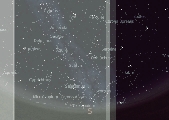 | 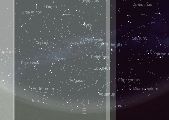 | click to the Summer Triangle with the southern horizon (top) and to the eastern horizon in summer (bottom). retrieve printer-friendly charts (Summer Triangle with the southern horizon, eastern horizon) |
Let's turn now to the last of the seasons. Fall. The autumn sky, like the one of spring, is a sky of transition. As the Summer Triangle is reaching to the horizon West, the first stars and constellations of the great winter sky are rising East. Let's begin West! Here is the Summer Triangle, that large triangle of three stars, relatively low now! The upper spike, high, is Deneb, of Cygnus, the Swan. To its lower right, northwest, just spot the bright Vega, of Lyra, the Lyra, and the last spike, low and maybe out of sight in some cases, is Altair, of Aquila, the Eagle. The small and fine constellations of Sagitta, the Arrow, Delphinus, the Dolphin, or Equuleus, the Little Horse are still accessible and fine fields and sights! Aquarius, the Water Bearer, high, southwest, is fine to spot and explore as Draco, the Dragon, is seen northwest, a fine meandering constellation. Fine views, for those not minding to raise their neck is provided, South, near the zenith, with the Great Square of Pegasus, the chain of Pisces, the Fishes, with the Circlet, that small loop of stars, and Cetus, the Whale
Let's turn East now! Like we saw the last gleamings of summer lying West, here are the fine stars and famed constellations of the great winter sky, dead East! The highest row, is featuring, starting slightly northeast, Capella, the bright star to the constellation Auriga, the Charioteer, and Taurus, the Bull, with Aldebaran. Aldebaran finely is located inside a V-shaped, loose open cluster, which is called the Hyades. Higher, the fine, tighter cluster of stars, if the famed Pleiades, a much fine sight! The row below, now. Albeit low somewhat, from slightly northeast to slightly southeast, you'll find Gemini, the Twins, with the two bright Castor and Pollux, as the other constellation there, is the famed, and well recognizable Orion, the Hunter! Orion is that fine quadrilaterial of stars, with three stars aligned in its center, which are called the Orion's Belt. The Orion Nebula is just lying below those. The whole southeast of the sky is see the meanders of Eridanus, the River, a celestial river which is taking at Rigel, of Orion, as it's ending its course far, in the southern hemisphere, at the star Achernar. The northeast, on the other hand, is home now to the faint Lynx, the Lynx
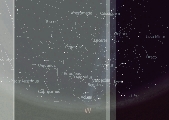 |  | click to fall sky western horizon (left) and eastern horizon (right). retrieve printer-friendly charts (western horizon, eastern horizon) |
At the end of this tour, we'll have a look at what are called the circumpolar constellations. "Circumpolar", in Latin, means "around the pole". Circumpolar constellations are constellations which are situated around the Polaris, about the northern horizon and with a relative position to the north celestial pole, that, whatever the season, in their rotation around there, they never pass under the horizon, remaining visible all year long. The rotation of the night sky -each night or along the seasons- never brings them under the northern horizon! The chart is showing the circumpolar constellations about March, 21st. Using the map of the diverse locations of the Great Dipper, just interpolate. Draco, the Dragon, is a fine meandering constellation, partly between the Great and the Little Dipper. Ursa Major, the Great Bear is, by March 21st, near the zenith. Cassiopeia, the Queen, or Cepheus, Cepheus, are exemplifying that the circumpolar constellations never wander under the northern horizon. Perseus, Perseus, is seen northwest. Camelopardalis, the Giraffe or Lynx, the Lynx, are faint fields and constellations. Ursa Minor -the famed Polaris of which is marking the North- is seen just about the star
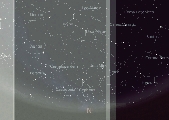 | click to circumpolar constellations. retrieve a printer-friendly chart |
The standard way to learn the sky is, like you did, from season to season, and through the horizon. Seasoned observers however do know that 'alignments' of stars allow to find one's way too into the night skies. Alignments of stars are just general and/or accurate directions given by two or more stars, which lead to such or such constellations or region of the sky. We chose below to give such alignments for the skies in the northern hemisphere. You'll note that, albeit leading to such distinctive features of the seasonal sky, like the great winter sky, or the Summer Triangle, these alignments mostly are to be used outside the considered such seasons. Most of them, on the other hand, are based on the Great Dipper, this easy to find asterism for the constellation Ursa Major, the Great Dipper (see above). You'll note too that some of the alignments following are considered standard to the amateur astronomy community -at least in the French-speaking world- as some may be own to our initiative only (as, in the latter case, they are of use however)
 | click to the alignment of stars allowing to the great winter sky (no printer-friendly chart) |
. How to Spot the Great Winter Sky
 | click to the alignment of stars allowing to Leo, Hydra (no printer-friendly chart) |
. How to Spot Leo, the Lion and Hydra, the Hydra. And 'Arc to Arcturus, Speed on To Spica' Too
 | click to the alignment of stars allowing to the Summer Triangle (no printer-friendly chart) |
. How to Spot the Summer Triangle
 | click to the alignment of stars allowing to the Great Square of Pegasus (no printer-friendly chart) |
. How to Spot the Great Square of Pegasus
Here you are. You have scoured the night sky along the seasons and from the great winter sky to the Summer Triangle, from Hercules to the Great Square of Pegasus and to the circumpolar constellations, you have now a better view of what our night sky is like. You may consider you just entered the amateur astronomers community! Should you feel that some parts of the sky are still badly understood, do not hesitate to come back to some parts of this page and to deepen your skills. On the other hand, each month, on this site, at the "Monthly Sky" section, you will find a view of the monthly western and eastern horizons. This will provide you with further insights as other tutorials about observation or about theory are helpful too
Website Manager: G. Guichard, site 'Amateur Astronomy,' http://stars5.6te.net. Page Editor: G. Guichard. last edited: 12/28/2010. contact us at ggwebsites@outlook.com